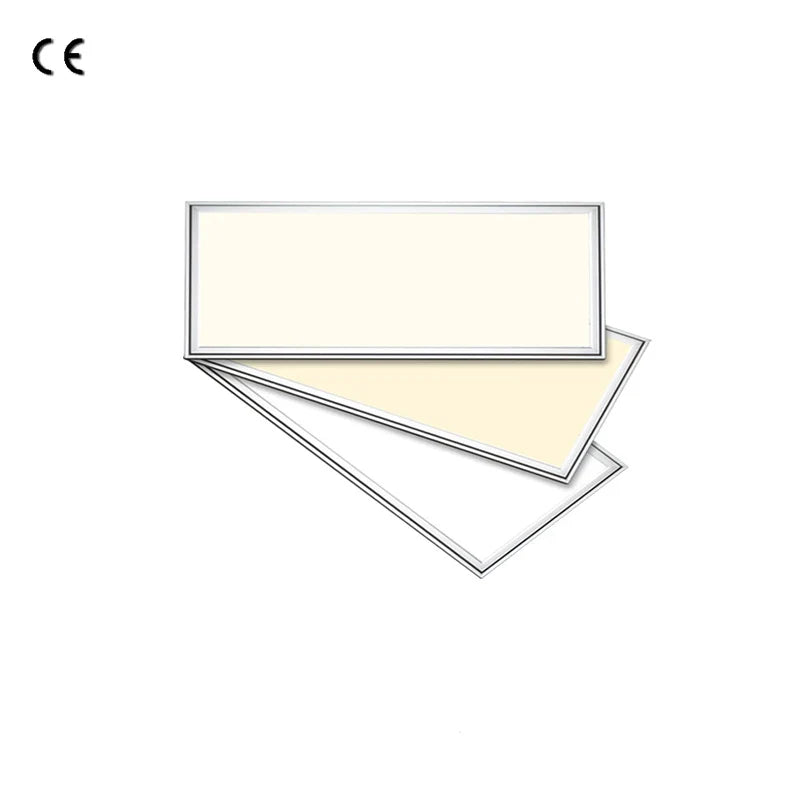In modern commercial and office lighting design, LED panel lights and LED troffer lights are among the most common ceiling lighting solutions. Both have their own strengths in terms of structure, optical performance, and visual comfort. For lighting designers, engineers, and business owners, understanding how these two types compare in luminous efficacy, Unified Glare Rating (UGR), and luminous uniformity is essential for choosing the right lighting system.
This article explores these three core performance factors in depth, offering a practical guide for optimizing both energy efficiency and lighting quality in commercial environments.
1. Luminous Efficacy: The Core of Energy Efficiency
Luminous efficacy (lm/W) measures how effectively a light fixture converts electrical energy into visible light—a key indicator of energy performance.
1.1 LED Panel Light Efficiency
LED panel lights use light-guide plates and diffusion films to distribute light evenly across the entire panel surface. They typically deliver 100–130 lm/W, with premium models reaching up to 150 lm/W. Thanks to their compact structure and minimal optical loss, they provide excellent efficiency for offices, hospitals, and retail spaces.
1.2 LED Troffer Light Efficiency
Troffer lights use reflective louvers or mirror-finished reflectors to control beam direction and reduce glare. Their efficacy usually ranges from 90–120 lm/W. While slightly lower than panel lights, their directional performance makes them ideal for applications where concentrated or controlled lighting is needed—such as laboratories, classrooms, and large office grids.
Conclusion:
If energy savings are your top priority, LED panel lights offer higher overall efficiency. However, for targeted or zoned illumination, LED troffers provide better optical control.
2. Unified Glare Rating (UGR): The Key to Visual Comfort
The Unified Glare Rating (UGR) quantifies how much glare a lighting system produces. The lower the UGR, the more comfortable the visual environment.
2.1 UGR Performance of Panel Lights
Because panel lights feature a broad, diffused light source, they naturally minimize direct glare. High-quality designs can achieve UGR < 19, meeting the visual comfort standards for offices, schools, and healthcare facilities. Advanced diffusion films further reduce eye strain during long work hours.
2.2 UGR Performance of Troffer Lights
Troffer lights rely on reflective louvers that precisely control beam direction, reducing direct line-of-sight glare while maintaining strong illumination. Many high-end models achieve UGR < 16–19, making them excellent for detailed visual tasks in conference rooms or design studios.
Conclusion:
Both options can meet modern low-glare lighting standards. However, troffers hold a slight advantage in strict glare-controlled environments thanks to their reflective geometry.
3. Luminous Uniformity: Ensuring Consistent Light Quality
Luminous uniformity (U) represents how evenly light is distributed across an area. Balanced illumination enhances both aesthetics and comfort in professional spaces.
3.1 Uniformity of Panel Lights
With their side-emitting light-guide structure, LED panel lights provide smooth, shadow-free brightness transitions. Their uniformity ratio can reach U ≥ 0.7, making them ideal for large, open spaces like hospitals, offices, and shopping corridors.
3.2 Uniformity of Troffer Lights
Troffer lights typically use point-source LEDs reflected through louvers. While they produce directional illumination, spacing between fixtures can lead to uneven lighting if not carefully designed. Proper layout and reflectance control are required to improve overall uniformity.
Conclusion:
When high uniformity is essential (e.g., showrooms or open-plan offices), panel lights are preferable. For spaces where zoned or focused lighting is required, troffers perform better.
4. Structure and Installation: Flexibility vs. Stability
LED panel lights are extremely thin (about 10mm) and can be recessed, surface-mounted, or suspended, offering flexibility across different ceiling types.
LED troffers, on the other hand, are designed primarily for T-grid ceilings and offer robust, easy-to-maintain installations.
From an aesthetic perspective, panel lights provide a modern, minimalist appearance, while troffers remain a durable and practical choice for industrial or traditional office environments.
5. Product Recommendations: High-Performance LED Panels and Troffers
Below is a selection of high-quality LED panel and troffer lights from LEDLightsWorld, covering a range of power ratings, dimensions, and applications to help you make the right choice:
| Product Name | Type | Key Features | Product Link |
|---|---|---|---|
| White Trim Square LED Panel Light | Panel Light | 10mm ultra-thin, recessed design, 100–240V AC input | View Product |
| White Trim Round LED Panel Light | Panel Light | Slim round shape, low power consumption, high brightness | View Product |
| 2x2 (600x600mm) LED Panel Light | Panel Light | UGR<19, glare-free, ultra-thin and bright | View Product |
| 1x2 (295x595mm) LED Panel Light | Panel Light | 24W energy-efficient, flicker-free and uniform lighting | View Product |
| 300×1200 LED Troffer Light (5 Pack) | Troffer Light | Dimmable, 3000K–6500K CCT options, ideal for offices & basements | View Product |
| 600×1200 LED Troffer Light (5 Pack) | Troffer Light | 40W–80W options, high lumen output for large commercial spaces | View Product |
| 2x4 (595x1195mm) LED Panel Light | Panel Light | Ultra-thin 10mm profile, high efficiency, glare-free illumination | View Product |
6. Conclusion: Balancing Performance and Application Needs
Both LED panel lights and LED troffer lights represent advanced, energy-efficient lighting technologies for modern interiors.
If your goal is to create a soft, evenly distributed, and visually comfortable light environment, LED panel lights are the best choice.
However, if you need precise beam control and optimized glare management, LED troffers deliver superior performance.
In many real-world projects, the two can be strategically combined—panel lights for general illumination and troffers for task or zone lighting—achieving the perfect balance of efficiency, aesthetics, and visual comfort.

